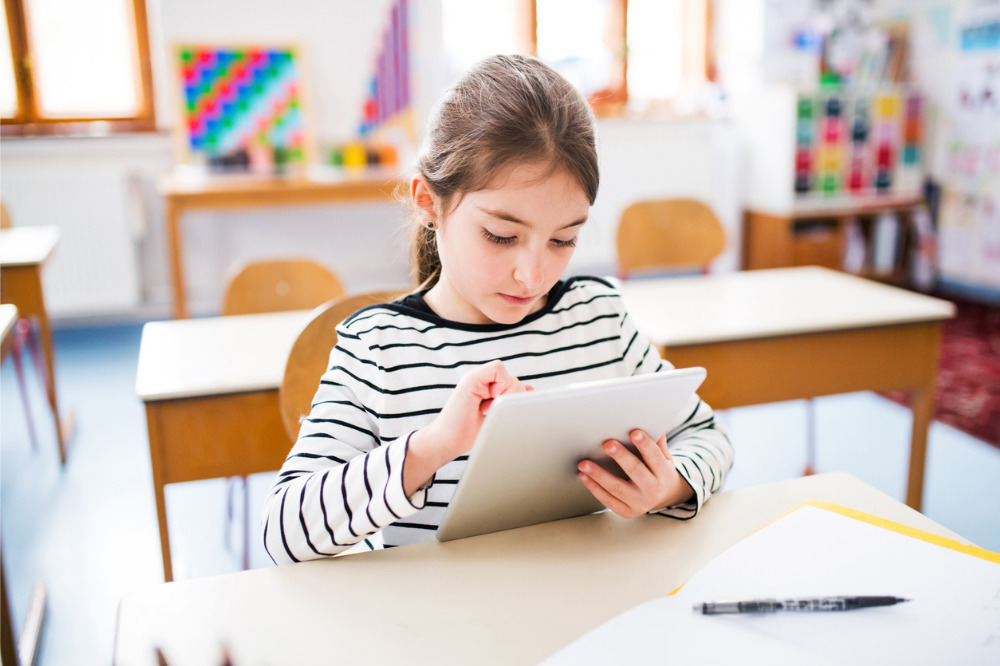
The merging of technology and education isn’t new, but the pace at which these two worlds are now colliding is increasing, and technology’s presence in the classroom is ever expanding.
Students in the Victorian era marvelled at the introduction of the magic lantern – an early version of the slide projector. The early 1900s saw the introduction of radio, shortly followed by overhead projectors and then videotapes. In the 1970s, mathematics classes charged into the 20th century with the introduction of electronic calculators.
Classroom technology stepped up another level when IBM released the first portable computer in 1981 and the first Apple Mac arrived in schools in 1984. In the early 1990s, the internet brought technology into classrooms and homes across the country.
“Technology has always had an impact on education—it has always found a way into the classroom but at a slower pace. The pandemic accelerated the impact and momentum,” Michelle Dennis, Head of Digital at Haileybury, told The Educator.
“Teachers are increasingly having to adopt technological tools to support their teaching methods and we’re seeing an increase in technology organisations not only willing to work with education, but to put education first.”
Dennis pointed to Microsoft’s OneNote, which was developed specifically to make the learning experience better, as an example of this.
“There are also tools now that allow students with dyslexia to read content in ways that make it easier to follow. Used in the right way, technology can be magic,” she said.
Haileybury has leveraged technology not only by teachers running separate Zoom rooms to accommodate different groups of students working on different tasks, but also provides a separate platform, Canvas, where resources and course materials can be shared.
Dennis said Canvas also provides an important avenue for students to engage with their classmates and for parents to stay connected with their child’s progress.
“Technology is also providing students with immediate feedback to better guide their learning,” she said.
“In video games, when you make a mistake, the game instantly reacts and you lose points or your character goes back to the starting point of the game. You learn from that, change what you are doing and try again.”
Dennis said when that concept is built into technology tools in the classroom, students can pick up new ideas more quickly and apply them.
“At Haileybury, we use an assessment system that ensures feedback is given at the right time by teachers annotating work or providing audio comments when students actually produce the work. It delivers feedback at the time when students need to hear it,” she said.
Ahead of the curve
Haileybury has been an early adopter of a raft of technological tools in its Early Learning Centres through to its Senior School classrooms. This forward-thinking approach to bringing the worlds of education and technology together and to investing in online delivery systems paid dividends during the pandemic.
During a series of lockdowns, Haileybury swiftly and smoothly transitioned to remote learning so classes could continue. Dennis said this no doubt played a role in the school continuing to achieve impressive VCE results.
This year, pending regulatory approval, Haileybury takes the combination of technology and education a step further with the launch of Australia’s first private virtual online school for school-age students, called Haileybury Pangea.
“Not everyone can physically access our campuses because of where they are or because of life circumstances and we want to provide an alternative approach to education,” Dennis said.
“Haileybury was looking at this pre-pandemic because there is a need for high quality, flexible education and technology can help deliver that.”
Dennis said that in an online classroom, students can have targeted time with teachers to develop their skills and receive materials to complete between classes so they keep learning at a time that suits them.
“The strength of technology truly emerges when it gives students more agency and control over their learning and adapts to each student in terms of the level and speed of learning.”
Dennis will teach one of Haileybury Pangea’s first subjects – Understanding Social Media Marketing.
Students will complete some VET units, learn the mechanics of social media marketing, build their media literacy skills and produce their own social media content using the latest Adobe products. While some of this will be done in online classrooms, skills will also be cemented outside the virtual classroom.
Dennis said that providing students with as many opportunities as possible to explore and use technology is vital to ensure they leave school with the skills needed in workplaces and communities now and in the future.
But while technology has an important place in classrooms, quality teaching is pivotal in underpinning education, she noted.
“There are some things that only a teacher can do exceptionally well, like relating to a student and initiating questions that can open up a new line of thinking. Technology that is thoughtful and evidence-based can help teachers do their jobs and provide insights,” she said.
“In the world of education, technology “has to be used at the right place and right time and when it makes the most sense. It’s not about using technology for technology’s sake, it’s about using technology in a genuine way to make learning better.”


